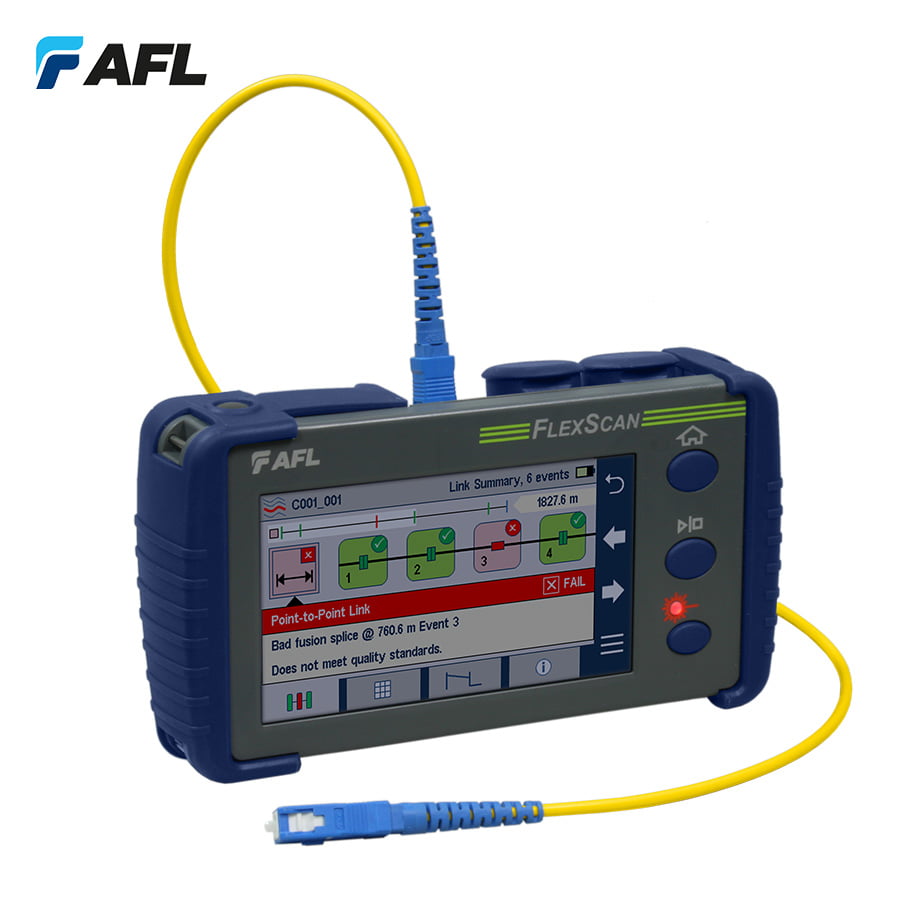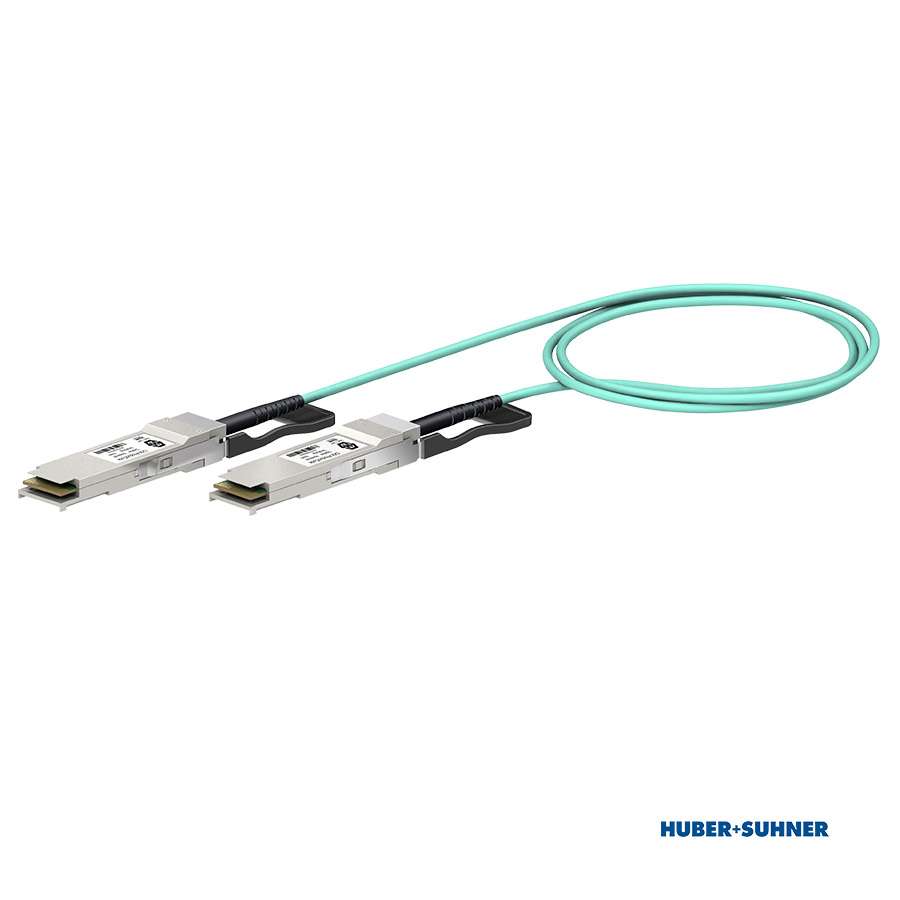More About This Product
The AFL FlexScan FS200 OTDR is an advanced OTDR fibre network tester that delivers high-performance from a pocket-sized unit that is user-friendly and affordable.
FlexScan FS200 OTDR from AFL
High-performance fibre networking testing
The FlexScan FS200 OTDR from AFL offers high-performance fibre networking testing from a pocket-sized OTDR that is user-friendly. It enables both novice and expert field technicians to quickly and reliably troubleshoot Passive Optical Networks (PON) and point-to-point optical networks, or fully characterise newly installed or repaired networks.
Thanks to the FlexScan FS200 OTDR’s innovative SmartAuto Mode, mulit-pulse and multi-wavelength features the OTDR can quickly and accurately scan, detect, identify and measure network components and faults. Testing can be conducted using industry-standard or user-defined pass/fail criteria, with the characterised network displayed using the FlexScan’s intuitive, icon-based LinkMap view.
The FS200 OTDR automates test setup, shortens test time and simplifies result interpretation, which improves efficiency and reduces test costs. The result data can then be stored internally or external, with internal data accessible via USB, Bluetooth or WiFi.
With optional connector inspection, integrated source, power meter and Visual Fault Locator (VFL), the FlexScan FS200 provides an all-in-one solution, that ensures field technicians have everything needed to locate and resolve fibre optic network issues. Uploaded results may be viewed and reports may be gathered using the included Windows® compatible TRM® Test Results Manager software.
FlexScan FS200 OTDR offers:
- SmartAuto provides network-optimised test settings – In SmartAuto mode, the FlexScan FS200 OTDR automatically determines the characteristics of the network under test and rapidly completes multiple scans using a variety of network-optimised acquisition settings.
- LinkMap simplifies network troubleshooting – LinkMap with Pass/Fail enables even novice users to easily and accurately troubleshoot optical networks. LinkMap presents an icon-based view of the tested network clearly identifying fibre start, end, connectors, splices, PON splitters, and macro-bends.
- Bluetooth and WiFi for faster connectivity – Pair FlexScan with AFL’s FOCIS Flex connector inspection probe for fast, easy connector end-face inspection.
- Multi-Functionality ensures complete testing accuracy – FlexScan FS200 OTDR integrates a Visual Fault Locator (VFL) plus an optional optical laser source (OLS) and optical power meter (OPM) supporting AFL’s unique Wave ID capability. With Wave ID, the power meter automatically synchronises to a single or multi-wavelength Wave ID optical signal sent by an AFL light source. The power meter automatically identifies received wavelengths and measures power and loss at each wavelength, saving significant test time and eliminating setup errors.
Features & Benefits
Features & Benefits
- Fast, accurate SmartAuto OTDR network characterisation or fault location.
- Easy to understand LinkMap results with pass/fail indications.
- 1310/1550/1650 nm PON OTDR (in- or out-of-service testing).
- 1310/1550 nm versions for complete network characterisation.
- 1550 nm only version for cost-effective troubleshooting.
- Alerts users to live fibres and poor launch conditions.
- Integrated Source, Power Meter, VFL (visual fault locator).
- Bluetooth and WiFi communications.
- Compatible with FOCIS Flex connector inspection system.
- Rugged, lightweight, hand-held for field use.
- Large, bright touchscreen display easily viewed indoors and out.
- Internal / external data storage via USB, Bluetooth, or WiFi.
- 12-hour Telcordia battery operation.
- PON or point-to-point network verification or troubleshooting.
- Optical network installation, troubleshooting and maintenance
- OTDR testing plus Insertion Loss and Power measurements.
- Locate faults exceeding industry or user pass/fail thresholds.
- Visually pinpoint location of macro-bends or breaks inside cabinets and splice closures.
Specifications
Specifications
| Model: FS200-# | -50 | -60 | -100 | -300 | -303 | -304 |
|---|---|---|---|---|---|---|
| OTDR | ||||||
| Emitter Type, Safety Class | Laser, Class I a | |||||
| Fibre Type | Single-mode | |||||
| Wavelengths (nm) | 1550 | 1650 | 1310/1550 | 1310/1550/1625 | 1310/1550/1650 | |
| Centre λ Tolerance b | 1310/1550/1650: ±20 nm; 1625 +30/-5 nm | |||||
| Dynamic Range (dB) c | 28 | 37 | 32/30 | 37/36 | 37/36/37 | |
| Event Dead Zoned | 1.0m | 0.8m | ||||
| Attenuation Dead Zone e | 6.0m | 3.5m | 3.6m | 3.5m | ||
| PON Dead Zone f | N/A | 30m | N/A | 25/25m | 25/25/30m | |
| Pulse Widths | 3, 5, 10, 20, 30, 50, 100, 200, 300, 500 ns; 1, 2, 3, 10; 20 μs (FS200-300/303/304 only) | |||||
| Range Settings | 250m to 240km | |||||
| Data Points | Up to 300,000 (Expert mode .SOR file) | |||||
| Data Spacing | 5cm to 16m | |||||
| Index of Refraction | 1.3000 to 1.7000 | |||||
| Distance Uncertainty (m) | ±(1 + 0.003% x distance + data point spacing) | |||||
| Linearity | ±0.05 dB/dB | |||||
| Trace File Format | Telcordia SR-4731 Issue 2 compatible .SOR | |||||
| Trace File Storage Medium | 4 GB internal memory (>5000 traces typical); External USB memory stick | |||||
| Data Transfer to PC | USB cable or Bluetooth® (option) | |||||
| OTDR Modes | SmartAuto, Expert, Real Time | |||||
| FleXpress Fast Test | FS200-300/303/304 | |||||
| Display Modes | LinkMap Summary, LinkMap Events, Trace | |||||
| Refresh Rate | Up to 4 Hz (Real-time mode) | |||||
| Live Fibre Protection | No OTDR damage with input power ≤ +15 dBm for wavelength(s) in range 1260 to 1675 nm | |||||
| Live Fibre Detection | Reports live fibre with input signal ≥ -35 dBm for wavelength(s) in range 1260 to 1675 nm | |||||
| PON Filter Isolation | >50 dB for 1260 nm ≤ wavelength ≤ 1600 nm | |||||
| Live PON OTDR Test | 1625 or 1650 nm using filtered detector | |||||
| Visual Fault Locator (VFL) | ||||||
| Emitter Type | Visible red laser, 650 ±20 nm | |||||
| Safety Class a | Class II | |||||
| Output Power | 0.8 mW into single-mode fibre (-1 dB ±0.5 dB) | |||||
| Modes | CW, 2 Hz flashing | |||||
| Model: FS200-# | -50 | -60 | -100 | -300 | -303 | -304 |
|---|---|---|---|---|---|---|
| Optical Laser Source – OLS (Optional) | ||||||
| Emitter Type, Safety Class | Laser, Class I a | |||||
| Fibre Type | Single-mode | |||||
| Wavelengths (nm) | 1550 | N/A | 1310/1550 | |||
| Centre λ Tolerance b | ±20 nm (CW mode) | |||||
| Spectral Width (FWHM) | 5 nm (maximum) | |||||
| Internal Modulation | 270 Hz, 330 Hz, 1 kHz, 2 kHz, CW, Wave ID | |||||
| Wave ID | Compatible with AFL OPM/OLS | |||||
| Output Power Stability | ≤ ±0.1 dB (15 minutes); ≤ ±0.15 dB (8 hours) | |||||
| Output Power | -3 dBm ±1.5 dB | |||||
| Optical Power Meter – OPM (Optional) | ||||||
| Calibrated Wavelengths | 1310, 1490, 1550, 1625, 1650 nm | |||||
| Detector Type | InGaAs, 1mm diameter | |||||
| Measurement Range | +23 to -50 dBm | |||||
| Tone Detect Range | +3 to -35 dBm | |||||
| Accuracy | ±0.25 dB | |||||
| Resolution | 0.01 dB | |||||
| Measurement Units | dB, dBm or Watts (nW, μW, mW) | |||||
| General | ||||||
| Size (in boot) | 86 x 160 x 43mm | |||||
| Weight | 0.4kg | |||||
| Operational Temperature g | -10°C to +50°C, 0 to 95 % RH (non-condensing) | |||||
| Storage Temperature | -40°C to +70°C, 0 to 95 % RH (non-condensing) | |||||
| Power | Rechargeable Li-Pol or AC adapter | |||||
| Battery Life | >12 hours, Telcordia test conditions | |||||
| Display | 4.3in Colour touchscreen LCD, 480×272, backlit | |||||
| USB Ports | 1 host; 1 micro-USB function | |||||
| Bluetooth (optional) | Compatible with Windows PC, Android | |||||
Notes: All specifications valid at 25°C unless otherwise specified.
a FDA 21 CFR 1040.10 and 1040.11, IEC 60825-1: 2014.
b Using 10 ns pulse width.
c SNR=1, longest range and pulse width, 3 minutes averaging.
d Maximum distance between the two points 1.5 dB down each side of a reflective spike caused by an event with reflectance ≤-45 dB using 3 or 5 ns pulse width.
e Maximum distance from the start of a trace spike caused by an event with a -45 dB (or smaller) reflectance, to the point where the trace returns to and stays within ±0.5 dB of backscatter.Test pulse is 3 or 5 ns.
f Recovery to within 0.5 dB of backscatter after 1:16 splitter (≤ 13 dB loss) using 100 ns pulse width.
g Maximum temperature while charging is +45°C.










